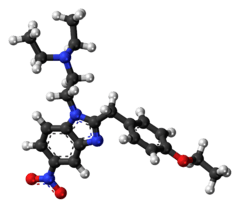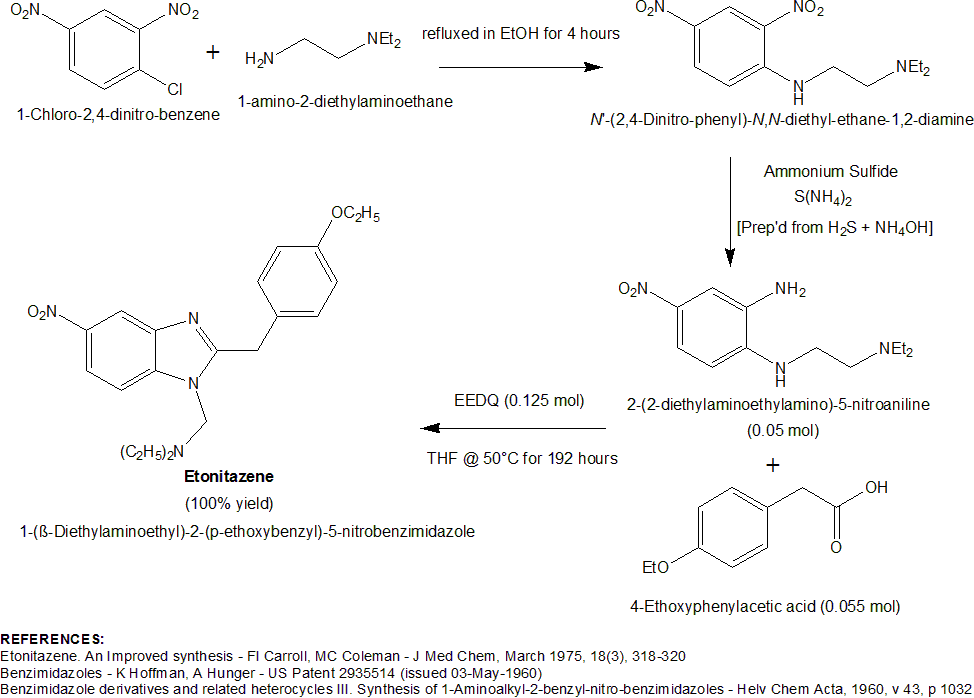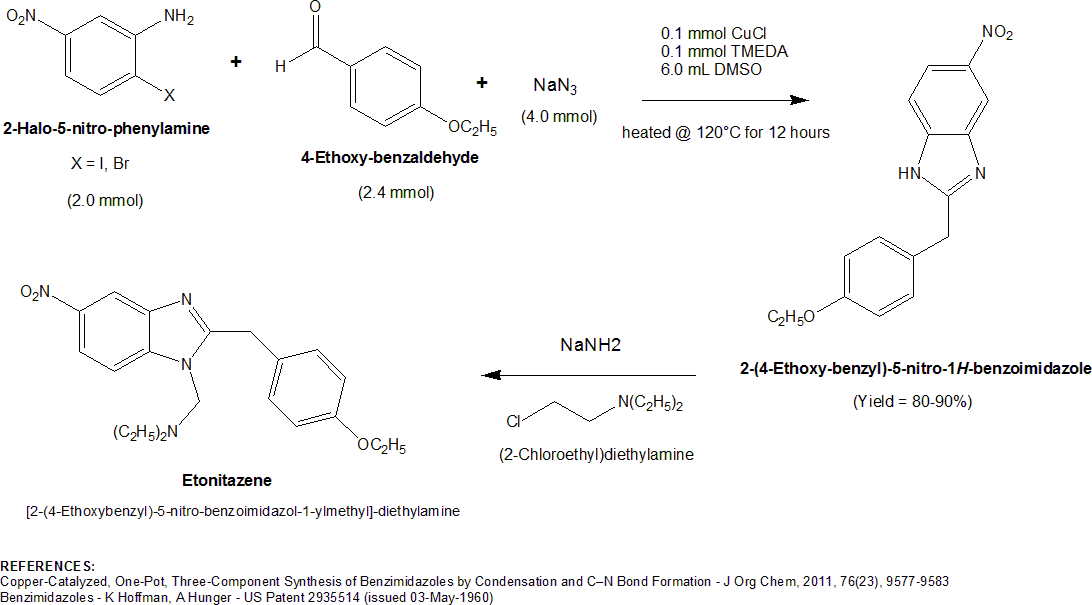Etonitazene
 | |
 | |
| Systematic (IUPAC) name | |
|---|---|
| 2-(p-Ethoxybenzyl)-1-diethylaminoethyl-5-nitrobenzimidazole | |
| Clinical data | |
| |
| Identifiers | |
|
911-65-9 | |
| None | |
| PubChem | CID 13493 |
| IUPHAR ligand | 1624 |
| DrugBank |
DB01462 |
| ChemSpider |
12908 |
| UNII |
9U3GT3353T |
| ChEMBL |
CHEMBL312040 |
| Chemical data | |
| Formula | C22H28N4O3 |
| 396.48 g/mol | |
|
SMILES
| |
| |
| | |
Etonitazene[1] is a potent analgesic drug shown to be approximately 1000–1500x the potency of morphine in animal models but only 60x in man.[2] It is one of several benzimidazole opioids, and is structurally related to clonitazene (where the p-ethoxybenzyl group is replaced by a p-chlorobenzyl group; however, clonitazene itself has only 3x the potency of morphine).
It has a strong dependency potential similar to that of morphine, and a strong tendency to produce respiratory depression, and is therefore not used in humans. It is however useful in addiction studies on animals. It is often used in studies requiring the animals to drink or ingest the opiate because it is not as bitter as the opiate salts, i.e., morphine sulfate.
It is the most potent benzimidazole opioid currently known.[3] Other analogues of considerable potency are as follows:

| Drug name | R | Analgesic Potency (Morphine = 1) |
|---|---|---|
| Etonitazene | ethoxy | 1000 |
| Clonitazene | chlorine | 3 |
| Nitazene | hydrogen | 2 |
| methyl | 10 | |
| ethyl | 30 | |
| propyl | 50 | |
| tert-butyl | 2 | |
| methoxy | 100 | |
| isopropoxy | 500 | |
| butoxy | 200 | |
| acetoxy | 5 | |
| methylthio | 50 | |
| ethylthio | 30 | |
Of these analogues, only etonitazene and clonitazene are explicitly listed as illegal drugs under UN convention and so are illegal throughout the world. The rest would only be illegal in countries such as the USA, Australia and New Zealand that have laws equivalent to the Federal Analog Act. In the United States it is a Schedule I Narcotic controlled substance with a DEA ACSCN of 9624 and a zero annual manufacturing quota as of 2013.
Etonitazene has proved very important in mapping out the opiate receptor and some experimental compounds in which phenolic groupings have been replaced with nitro groupings have proved more active than the parent compound.
Illicit production and sale of etonitazene has been limited. This compound was identified on the illegal drug market in Moscow in 1998, appeared to have been illicitly manufactured, and was primarily smoked as pre-laced cigarettes.[4] In another case a chemist at Morton Thiokol called Thomas K Highsmith [5] produced the compound and placed it in a nasal inhaler.
Synthesis
Etonitazene and its related opioid agonist benzimidazoles were discovered in the late 1950s,[6][7][8][9][10][11] by a team of Swiss researchers working at the pharmaceutical firm CIBA (now Novartis). One of the first compounds investigated by the Swiss team was 1-(β-diethylaminoethyl)-2-benzylbenzimidazole, which was found to possess 10% of the analgesic activity of morphine when tested in rodent bioassays. This finding encouraged the group to begin a comprehensive systematic study of 2-benzylbenzimidazoles and to establish the structure-activity relationship of this new family of analgesics. Two general synthetic methods were developed for the preparation of these compounds.
The first method involved the condensation of o-phenylenediamine with phenylacetonitrile to form a 2-benzylbenzimidazole. The benzimidazole is then alkylated with the desired 1-chloro-2-dialkylaminoethane, forming the final product. This particular procedure was most useful for the preparation of benzimidazoles that lacked substituents on the benzene rings. A diagram of this method is displayed below.[12]
The most versatile synthesis[13] developed by the Swiss team first involved alkylation of 2,4-dinitrochlorobenzene with 1-amino-2-diethylaminoethane to form N-(β-Diethylaminoethyl)-2,4-dinitroaniline [aka: N'-(2,4-Dinitrophenyl)-N,N-diethyl-ethane-1,2-diamine]. The 2-nitro substituent on the 2,4-dinitroaniline compound is then selectively reduced to the corresponding primary amine by utilizing ammonium sulfide as the reducing agent. The ammonium sulfide can be formed in situ by the addition of concentrated aqueous ammonium hydroxide followed by saturation of the solution with hydrogen sulfide gas. The intermediate formed by the selective reduction of the 2-nitro substituent, 2-(β-Diethylaminoethylamino)-5-nitroaniline, is then reacted with the hydrochloride salt of the imino ethyl ether of 4-ethoxyphenylacetonitrile (aka: p-ethoxybenzyl cyanide). The imino ether, 2-(4-Ethoxyphenyl)-acetimidic acid ethyl ester hydrochloride, is prepared by dissolving the 4-substituted benzyl cyanide in a mixture of anhydrous ethanol and chloroform and then saturating this solution with dry hydrogen chloride gas. The reaction between the 2-(β-dialkylaminoalkylamine)-5-nitroaniline and the HCl salt of the imino ethyl ether results in the formation of etonitazene. This procedure is particularly useful in the preparation of the 4-, 5-, 6-, and 7-nitrobenzimidazoles. Varying the choice of the substituted phenylacetic acid imino ether affords compounds with a diversity of substituents on the benzene ring at the 2- position. A diagram of this particular synthesis as it applies to the preparation of etonitazene is shown below.[14]

A particularly novel, high-yielding synthesis of etonitazene was developed by FI Carroll and MC Coleman in the mid-1970s[15] (J Med Chem, March 1975, Vol. 18, No. 3, pp 318–320). The authors were tasked with the preparation of large quantities of etonitazene, but found the conventional synthesis to be inadequate. The problem with the conventional synthesis was the lability of the imino ether reactant, 2-(4-Ethoxyphenyl)-acetimidic acid ethyl ester (prepared by reacting 4-ethoxyphenylacetonitrile with ethanolic HCl). The imino ether necessitated the use of anhydrous reaction conditions and was inconvenient to prepare in large quantities. This led the authors to experiment with the use of a coupling reagent, EEDQ (N-Ethoxycarbonyl-2-ethoxy-1,2-dihydroquinoline), in order to promote the condensation of 2-(2-diethylaminoethylamino)-5-nitroaniline with 4-ethoxyphenylacetic acid. Incredibly, the authors discovered that when this condensation was performed in the presence of 2 or more molar equivalents of EEDQ (added portionwise in 3 steps) in THF at 50°C for 192 hours (8 days), a near quantitative yield (100%) of etonitazene was obtained. In addition to the impressive improvement in yield over the conventional procedure, the work up procedure was greatly simplified since quinoline, carbon dioxide, and ethanol were the only by-products formed. A diagram of this procedure is shown below.

A 2011 publication[16] [J. Org. Chem., 2011, 76(23), 9577-9583] from a South Korean team outlined a novel, one-pot synthesis for substituted and unsubstituted 2-benzyl-benzimidazoles that can be easily adapted to the preparation of etonitazene. The three component synthesis of the direct etonitazene precursor, 2-(4-Ethoxybenzyl)-5-nitro-1H-benzoimidazole, consists of a 2-Bromo- or 2-Iodo-5-nitro-phenylamine (1.0 molar equivalent), a 4-substituted benzaldehyde (1.2 equiv), and sodium azide (2 equiv). The 2-Halo-5-nitro-phenylamine requires a bromo or iodo group for optimal activity. 2-Chloro-phenylamines are completely unreactive. In addition to these three components, the reaction was optimized in the presence of 0.05 molar equivalents (5 mol%) of a catalyst, copper(I) chloride, and 5 mol% of ligand, TMEDA (tetramethylethylenediamine). After heating these components at 120°C for 12 hours in DMSO, the direct etonitazene precursor, 2-(4-Ethoxybenzyl)-5-nitro-1H-benzoimidazole, was formed in an approx 80-90% yield. The secondary amine nitrogen of 2-(4-Ethoxybenzyl)-5-nitro-1H-benzoimidazole was then alkylated with (2-Chloroethyl)diethylamine to form etonitazene.[17] A diagram of this synthesis is shown below.

References
- ↑ US patent 2935514, Karl Hoffmann et al, "BENZIMIDAZOLES", published 1957-09-19, issued 1960-05-03
- ↑ Factors regulating oral consumption of an opioid (etonitazene) by morphine-addicted rats - PSYCHOPHARMACOLOGY Volume 5, Number 1, 55-76
- ↑ Benzimidazole Opioids 3.pdf
- ↑ Sorokin VI, Ponkratov KV, Drozdov MA. Etonitazene Encountered in Moscow. MICROGRAM 1999; 32(9): 239-244
- ↑ "Chemist charged in drug case". Deseret News (Salt Lake City).
- ↑ Hunger, A.; Kebrle, J.; Rossi, A.; Hoffmann, K. (1 October 1957). "Synthese basisch substituierter, analgetisch wirksamer Benzimidazol-Derivate" [Synthesis of analgesically active benzimidazole derivatives with basic substitutions]. Experientia 13 (10): 400–401. doi:10.1007/BF02161116. PMID 13473817.
- ↑ Rossi, A.; Hunger, A.; Kebrle, J.; Hoffmann, K. (1960). "Benzimidazol-Derivate und verwandte Heterocyclen. IV. Die Kondensation von o-Phenylendiamin mit α-Aryl- und γ-Aryl-acetessigester" [Benzimidazole derivatives and related heterocycles IV. The condensation of o-phenylenediamine with α-aryl and γ-aryl-acetoacetate]. Helvetica Chimica Acta (in German) 43 (4): 1046–1056. doi:10.1002/hlca.19600430413.
- ↑ Rossi, A.; Hunger, A.; Kebrle, J.; Hoffmann, K. (1960). "Benzimidazol-Derivate und verwandte Heterocyclen V. Die Kondensation von o-Phenylendiamin mit aliphatischen und alicyclischen β-Ketoestern" [Benzimidazole derivatives and related heterocycles V. The condensation of o-phenylenediamine with aliphatic and alicyclic β-keto esters]. Helvetica Chimica Acta (in German) 43 (5): 1298–1313. doi:10.1002/hlca.19600430515.
- ↑ Hunger, A.; Kebrle, J.; Rossi, A.; Hoffmann, K. (1960). "Benzimidazol-Derivate und verwandte Heterocyclen VI. Synthese von Phenyl-[1-aminoalkyl-benzimidazolyl-(2)]-essigsäure-estern und -amiden" [Benzimidazole derivatives and related Heterocycles VI. Synthesis of phenyl-[1-aminoalkyl-benzimidazolyl-(2)]-acetic acid esters and amides]. Helvetica Chimica Acta (in German) 43 (6): 1727–1733. doi:10.1002/hlca.19600430634.
- ↑ Hunger, A.; Kebrle, J.; Rossi, A.; Hoffmann, K. (1961). "Benzimidazol-Derivate und verwandte Heterocyclen VII. Synthese neuer 2-Amino-benzimidazole" [Benzimidazole Derivatives and related Heterocycles VII. Synthesis of new 2-amino-benzimidazole]. Helvetica Chimica Acta (in German) 44 (5): 1273–1282. doi:10.1002/hlca.19610440513.
- ↑ Gross, F.; Turrian, H. (1 October 1957). "Über Benzimidazolderivate mit starker analgetischer Wirkung" [Benzimidazole derivatives with strong analgesic effects]. Experientia 13 (10): 401–403. doi:10.1007/BF02161117. PMID 13473818.
- ↑ Hunger, A.; Kebrle, J.; Rossi, A.; Hoffmann, K. (1960). "Benzimidazol-Derivate und verwandte Heterocyclen. II. Synthese von 1-Aminoalkyl-2-benzyl-benzimidazolen" [Benzimidazole derivatives and related heterocycles II. Synthesis of 1-aminoalkyl-2-benzyl-benzimidazoles]. Helvetica Chimica Acta (in German) 43 (3): 800–809. doi:10.1002/hlca.19600430323.
- ↑ Hunger, A.; Kebrle, J.; Rossi, A.; Hoffmann, K. (1960). "Benzimidazol-Derivate und verwandte Heterocyclen III. Synthese von 1-Aminoalkyl-2-nenzyl-nitro-benzimidazolen" [Benzimidazole derivatives and related heterocycles III. Synthesis of 1-Aminoalkyl-2-benzyl-nitro-benzimidazoles]. Helvetica Chimica Acta (in German) 43 (4): 1032–1046. doi:10.1002/hlca.19600430412.
- ↑ Hunger, A.; Kebrle, J.; Rossi, A.; Hoffmann, K. (1 October 1957). "Synthese basisch substituierter, analgetisch wirksamer Benzimidazol-Derivate" [Synthesis of analgesically active benzimidazole derivatives with basic substitutions]. Experientia 13 (10): 400–401. doi:10.1007/BF02161116. PMID 13473817.
- ↑ Carroll, FI; Coleman, MC (March 1975). "Etonitazene. An improved synthesis.". Journal of Medical Chemistry 18 (3): 318–20. doi:10.1021/jm00237a024. PMID 237125.
- ↑ Kim, Y; Kumar, MR, Park, N, Heo, Y, Lee, S (2011-12-02). "Copper-catalyzed, one-pot, three-component synthesis of benzimidazoles by condensation and C-N bond formation.". The Journal of Organic Chemistry 76 (23): 9577–83. doi:10.1021/jo2019416. PMID 22034860.
- ↑ Hunger, A.; Kebrle, J.; Rossi, A.; Hoffmann, K. (1960). "Benzimidazol-Derivate und verwandte Heterocyclen. II. Synthese von 1-Aminoalkyl-2-benzyl-benzimidazolen" [Benzimidazole derivatives and related heterocycles II. Synthesis of 1-aminoalkyl-2-benzyl-benzimidazoles]. Helvetica Chimica Acta (in German) 43 (3): 800–809. doi:10.1002/hlca.19600430323.